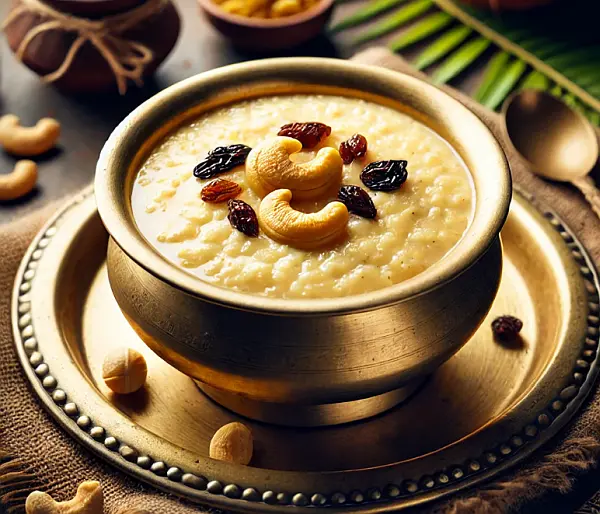Payasam
Kerala’s Beloved Sweet Dessert

Payasam, also known as "kheer" in North India, is a traditional South Indian dessert that holds a special place in Kerala’s culinary traditions. This rich, creamy sweet dish is made with either rice, vermicelli, or sometimes lentils, cooked slowly in milk (or coconut milk) and flavored with cardamom, saffron, and sometimes nuts and raisins. Payasam is a staple in Kerala’s festive celebrations, religious ceremonies, and special occasions, often served at the end of a grand meal or as part of a Kerala Sadya feast.
The Different Types of Payasam
Kerala offers a variety of Payasam recipes, each with unique ingredients and flavors. Here are some popular types:
- Pal Payasam: This is the classic milk-based payasam made with rice, sugar, and milk. Slow-cooked until the rice becomes soft and creamy, Pal Payasam is simple yet delicious, with a subtle sweetness and rich texture.
- Ada Pradhaman: Considered the king of payasams, Ada Pradhaman is made with rice flakes (ada) cooked in coconut milk and sweetened with jaggery. It is flavored with cardamom and garnished with fried coconut slices, cashews, and raisins.
- Semiya Payasam: Made with vermicelli (semiya) instead of rice, this variety is popular for its light texture and quick preparation. It’s cooked with milk, sugar, and a hint of cardamom, and often garnished with fried cashews and raisins.
- Parippu Payasam: This unique version is made with moong dal (split yellow lentils) instead of rice or vermicelli. The lentils are cooked in coconut milk with jaggery, creating a rich, creamy, and nutty dessert that’s often flavored with cardamom and ghee.
- Chakka Pradhaman: Made with ripe jackfruit, this seasonal payasam has a unique flavor. The jackfruit pulp is cooked in coconut milk and jaggery, giving it a distinctive sweetness and aroma.
Each type of payasam reflects Kerala’s bounty of ingredients, from rice to coconut milk to jaggery, highlighting the diversity within Kerala’s traditional desserts.
Key Ingredients in Payasam
While payasam recipes vary, some ingredients are essential across all types:
- Base Ingredient: This can be rice, vermicelli, lentils, or even fruits like jackfruit or banana, depending on the type of payasam.
- Milk or Coconut Milk: For a creamy texture, payasam is typically made with milk, but coconut milk is often used in Kerala for a distinct flavor, especially in jaggery-based payasams like Ada Pradhaman.
- Sweeteners: Sugar is used in milk-based payasams, while jaggery is preferred for coconut milk-based payasams, adding a deep, caramel-like flavor.
- Cardamom and Saffron: These spices enhance the aroma and add warmth to the dessert. Cardamom is a staple flavor in almost every type of payasam.
- Nuts and Raisins: Fried cashews and golden raisins are used for garnish, adding a crunchy texture and richness.
- Ghee: Ghee (clarified butter) is used to fry the nuts and sometimes added to the payasam for a richer flavor.
How Payasam is Made
Payasam is made by slow-cooking the main ingredient (rice, vermicelli, or lentils) in milk or coconut milk until it absorbs the flavors and reaches a creamy consistency. Here’s the typical process:
- Cooking the Base Ingredient: The rice, vermicelli, or dal is cooked until soft, either directly in milk or separately in water.
- Simmering in Milk or Coconut Milk: The cooked ingredient is added to simmering milk or coconut milk, along with sugar or jaggery, and allowed to cook slowly to absorb the flavors.
- Flavoring with Spices: Cardamom powder and saffron are added for aroma, along with any other desired spices.
- Garnishing: Cashews and raisins are fried in ghee until golden and sprinkled on top, adding texture and richness to the dessert.
The result is a warm, creamy dessert with a delightful balance of flavors and a smooth, melt-in-the-mouth texture.
Flavor Profile and Texture of Payasam
Payasam is known for its rich, creamy texture and mild sweetness, balanced by the warm, aromatic flavor of cardamom. In jaggery-based versions, the caramel notes add depth, while the coconut milk gives it a slightly nutty flavor. The fried cashews and raisins provide a contrast to the smooth, creamy base, making every bite interesting. The milk-based varieties like Pal Payasam have a more subtle, comforting sweetness, while jaggery-based varieties like Ada Pradhaman offer a bolder, more complex taste.
Cultural Significance of Payasam
In Kerala, payasam is more than just a dessert—it’s an integral part of celebrations and rituals. Payasam is traditionally served as a dessert during the Sadya, the grand vegetarian feast served on a banana leaf during festivals like Onam and Vishu, as well as weddings. It is often prepared in large quantities and served as an offering in temples, symbolizing prosperity, gratitude, and joy. Payasam is also prepared at home to mark auspicious occasions, family gatherings, and special milestones.
Health Benefits of Payasam
While payasam is indulgent, it also offers certain nutritional benefits:
- Nutrient-Rich Ingredients: Ingredients like rice, vermicelli, and lentils provide carbohydrates and fiber, while milk or coconut milk adds healthy fats and protein.
- Antioxidants from Spices: Cardamom and saffron are rich in antioxidants, promoting heart health and aiding digestion.
- Energy from Jaggery: Jaggery used in many payasam recipes provides a natural source of energy and contains minerals like iron and magnesium.
Enjoyed in moderation, payasam can be a satisfying and nourishing treat.
Experiencing Payasam: A Must for Visitors
For those visiting Kerala, trying payasam is a delightful way to experience the region’s traditional sweets. Many restaurants and traditional eateries serve payasam as part of their Kerala meals, and it’s also a common offering in temples. During festivals like Onam, payasam is widely available, allowing visitors to enjoy an authentic taste of Kerala’s festive desserts. Sampling different types of payasam offers a deeper understanding of Kerala’s food culture and appreciation for its local ingredients.
How to Enjoy Payasam
Payasam is best enjoyed warm or at room temperature; though some varieties can also be enjoyed chilled. Its creamy consistency makes it ideal as a standalone dessert or as a sweet end to a spicy meal. In traditional Kerala meals, payasam is typically served in small cups or banana leaf sections at the end of the Sadya, symbolizing sweetness and prosperity.
Payasam is a cherished dessert in Kerala that celebrates the region’s culinary heritage through its rich flavors, creamy texture, and use of local ingredients. Whether enjoyed as part of a festive Sadya, a temple offering, or a sweet treat at home, payasam is a comforting and indulgent dessert that brings people together. For anyone exploring Kerala’s cuisine, payasam is a must-try that offers a delicious taste of tradition and celebration.
